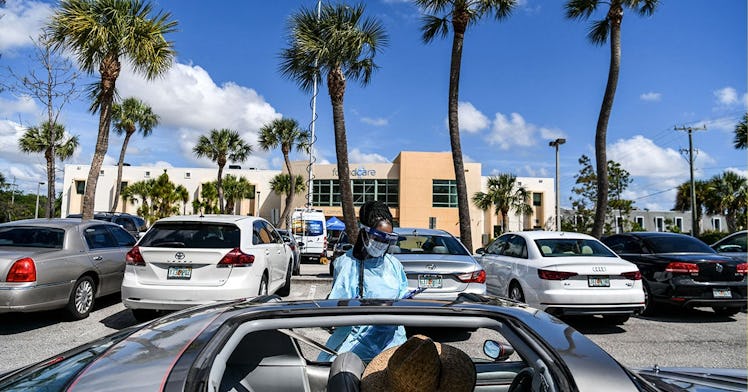Florida Has the Country’s Lowest COVID Rates — Here Are 5 Major Takeaways
These low rates came at a high cost.

For every 100,000 people in Florida, an average of eight have COVID right now – the lowest COVID rate in the U.S., according to the New York Times COVID Tracker. Yes, we’re talking about the same Florida that has blocked federal funding from reaching schools that enforce their own mask mandates. How can that be? It’s not Gov. Ron DeSantis’ policies that are behind the state’s current COVID success, right? Well, in a very roundabout way, a lack of COVID precautions has played a major role in bringing Florida to its current low case rate – but that’s not a good thing. The reason COVID is comparatively sparse in Florida right now is that the state is coming off one of the worst Delta surges in the country, which left a lot of people with natural immunity, but hospitalized and killed many others in the process. This leads us to our first takeaway:
Takeaway #1: Florida’s Low COVID Rates Follow a Wake of Carnage
“For over six weeks, Florida was in the top three highest rates of new infections in the nation,” says Jason Salemi, PhD, an epidemiologist at the University of South Florida College of Public Health. “For every single age group, we experienced higher hospitalization rates than we had at any other point in the pandemic.” The state faced high numbers of deaths too, higher than it had at any other point in the pandemic. At its worst, in the beginning of September, 381 people were dying of COVID each day in Florida, Salemi says. “It burned through the population quite rapidly.”
After about two months of this carnage, cases fell until they reached the current point, says Mary Jo Trepka, MD, chair of the epidemiology department at Florida International University’s Robert Stempel College of Public Health & Social Work. At that point, there weren’t many susceptible people left. Many of those who hadn’t been vaccinated had been exposed to the Delta variant and developed natural immunity against it. “You end up getting so many people who are infected that the virus has trouble finding people who have not recently been infected,” she says.
This boom-and-bust cycle of COVID isn’t unique to Florida. It’s happened many times throughout the pandemic, notably in India and the UK. A population will experience a high surge, and about two months later, case rates will begin to decline. Experts aren’t entirely sure what causes this identifiable pattern.
Takeaway #2: Florida’s Summer Surge Didn’t Have to Happen
The Delta summer surge in Florida was largely preventable. Vaccines and other precautions such as mask-wearing could have helped flatten the curve. “That’s what’s shocking about all of this, is our worst peak ended up well after the vaccines were available,” Salemi says. Although 59 percent of the state’s population is fully vaccinated, which is slightly above the national average, it only climbed that high because the Delta surge scared Floridians into getting the shot.
Sure, if COVID hadn’t spiked so high over the summer, case rates probably wouldn’t be so low now. But all in all, lives would be saved. Besides, Florida could have reached the same results through vaccination.
Takeaway #3: The Weather Is Helping Florida’s COVID Rates Right Now
Although the end of the summer surge is the main reason Florida’s cases are low right now, some other factors probably play a role, such as the weather. In much of the country, people spend more time outside during the summer, where COVID gets dispersed quickly and transmission is less likely. But in Florida, the summer can be unbearable. Residents may actually flock inside to beat the heat and humidity, which probably didn’t help the surge. Now that the weather is cooling off in the South, people are moving outside, which likely has helped infections to decline.
Takeaway #4: COVID Rates Are Relative
It’s important to note that although COVID rates across the country are lowest in Florida right now, that’s relative. Case rates in Florida are not objectively low. In fact, the Centers for Disease Control and Prevention still considers community transmission in the state to be “substantial.” That’s only one step down from “high,” which most of the country is labeled.
“Here in South Florida, we’re still not down to where we were in the late spring,” Trepka says. “There still is transmission going on. There’s still hospitalizations going on. And there still are people who are dying.”
Takeaway #5: Relying on Natural Immunity Is Really, Really Risky
Just because rates are relatively low in Florida now doesn’t mean they will stay that way. In the months ahead, people relying on natural immunity may see it wane, Trepka says. The winter months may see another surge with a new variant, and there’s no guarantee that unvaccinated people who were exposed to Delta will be safe from getting sick.
This article was originally published on